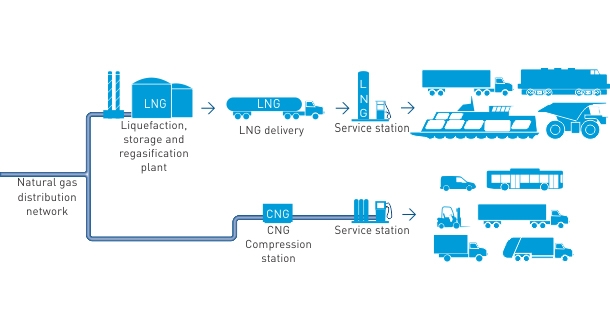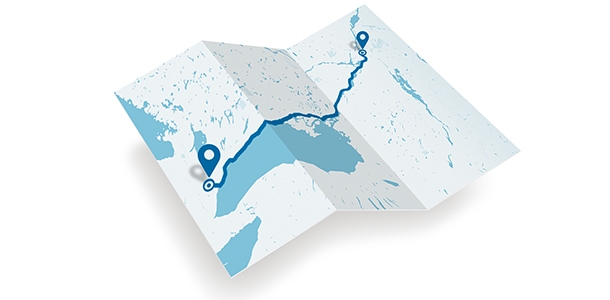An industry known as a major emitter
The transportation industry is the largest greenhouse gas (GHG) emitter in Québec, accounting for 43% of emissions. Heavy vehicles using diesel emit 28% of this total.
An immediate solution
A truck that runs on natural gas instead of diesel reduces greenhouse gas emissions by up to 25% as well as almost completely eliminating the emission of air pollutants.
Why not electricity?
No reliable technology currently exists to allow medium and heavy trucks to run on electricity. However, such trucks can turn to liquefied or compressed natural gas to reduce their GHGs.
Two types of natural gas as fuel
Since natural gas has less energy per volume than diesel or gasoline, it must be liquefied or compressed for it to store the same quantity of energy in a vehicle.
When it is cooled to -160°C, natural gas becomes a liquid and occupies a volume that is 600 times smaller. Liquefied natural gas (LNG) is ideal for long-distance travel or for heavy loads. LNG is stored in double-walled cryogenic tanks and is re-gasified when it flows from the tank to the engine. It is primarily used in the road, maritime and rail transportation sectors.
However, compressed natural gas (CNG) can be stored at 300 times atmospheric pressure, which reduces the volume by an equal amount. Therefore, it is the ideal candidate for short-range daily trips such as household garbage and recycling trucks, mail delivery trucks, intercity buses and all types of municipal vehicles, including ice resurfacers.
Supply dynamics
Liquefied natural gas comes from Gaz Métro's liquefaction, storage and regasification (LSR) plant. The plant has a loading dock for filling tanker trucks, which supply refuelling stations. Compressed natural gas comes from the underground natural gas network, and is then stored in high-pressure tanks at fuelling stations.


Fuelling stations
In order to keep moving forward, accessible fuelling stations must obviously be provided. Introduced in 2011, the Blue Road is the first public network of natural gas refuelling stations. Some of the stations are located along the corridor connecting Québec City and Toronto, which is used by over 48,000 heavy trucks each week. In its energy policy, the Québec government has planned to establish several multi-fuel stations across the province by 2030.
Increasing popularity
More and more companies are adding trucks that run on natural gas to their vehicle fleet. Transport Robert was the pioneer in Québec, followed by several others, such as Gaudreau Environment Inc., Canadian American Transportation Inc., EBI, Sani-Estrie, Molson and Provigo, to only name a few. Across the world, more than 22 million vehicles currently run on natural gas; over 700 of them are in Québec.

Natural gas and transportation - it's just a start!
Barely five years, trucks running on natural gas were still quite rare. And now they are increasing in number on Québec’s highways. More economical and cleaner than diesel, natural gas(…)
Natural gas takes to the road
Is natural gas about to dethrone diesel to become the road transport fuel of the 21st century? That prediction may seem bold, but the more and more rapid adoption of(…)
